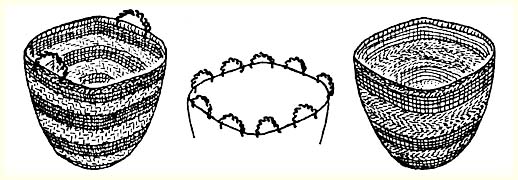
|

|
|
Early West Coast Culture (Précis, Chapter 19)
Around 4,000 B.C. increasing cultural
regionalism from the preceding cultural base established by
Southwestern Coastal culture and Northwestern Coastal culture is
apparent. These two earlier cultures may simply represent geographic
variations of a single culture. Stabilization of the coastal
environment appears to have encouraged the development of
increasingly complex cultural adaptations. As a result of the more
or less stable sea levels, riverine deltas and tidal flats were able
to support richer coastal and riverine ecosystems. Within these
ecosystems, salmon, eulachon, and shellfish were of particular
importance. The appearance of large shell middens represents a major
difference from the preceding period. Red cedar, so critical to the
material culture of the ethnographic West Coast people, also became
more available. Progressively larger village sites reflect a
settlement pattern approaching the coastal winter villages recorded
at the time of European contact. It is only at the end of Period III,
however, that direct evidence of plank house villages appears. Art
work was still relatively rudimentary and arguments for social
structure changes represented by the appearance of certain status
objects are not convincing until after 3,000 B.C. It is apparent,
however, that cultural systems were progressively trending towards
the cultural pattern documented by Europeans. A seasonal pattern of
coastal winter settlement in the deltas of major rivers, such as the
Fraser and Skeena, with summer interior extensions up the rivers to
key salmon capturing and processing locations was evolving
throughout Period III and would eventually lead to permanent interior
settlements. Within a broad cultural pattern sometimes referred to as
the Northwest Coast culture type, distinctive regional patterns were
already in existence. Not only are there differences which
characterize the southern, central and northern coastal regions but
both the outer coasts of Vancouver Island and the Queen Charlotte
Islands developed in ways distinct from that of the mainland coast.
Finer distinctions have been noted within each particular region.
Three major subareas, for example, have been identified for the
south coast
(Mitchell 1990: 357). Indeed,
there is a plethora of regional cultural designations. If the Northwest
Coast 'culture type' of Period III is considered progressing from north
to south along the coast then the following local names by regions
pertain: North Coast - Prince Rupert/Skeena River - Prince
Rupert III/Haqwilget A, Gitaus VI, and Skeena Complex; Queen Charlotte
Islands - Transitional complex and Graham tradition; North-Central
Coast - Namu II and III, McNaughton I, and Cathedral phase;
South-Central Coast - Bear Cove II and O'Conner II; West Coast of
Vancouver Island - Early and part of Middle Yuquot, Shoemaker Bay
I; Georgian Strait and Lower Fraser - Maurer, St.Mungo phase and
the early portion of the Locarno Beach phase; Gulf and San Juan
Islands - Mayne phase, and the early portion of the Locarno Beach
phase; and Fraser Canyon - Eayem and early Baldwin phases
(Carlson 1983: Figure 1:2). All
of these regional classifications are here lumped under the rubric
'Early West Coast culture.
|

Common Musqueam Northeast Basket Forms
|

A Wrap Around Plaiting |
B Checker |
C Open Wrapping
|

Cordage Varieties
A Single strand withe, twist to the right (s twist) |
B Two-strand cordage, laid to the right (z twist) |
C Three-strand cordage, laid to the right (z twist) |
D Four-strand cordage, laid to the right (z twist)
|
Early West Coast Culture Basketry and Cordage
Due to water saturated soil
conditions in the lower deposits of the Musqueam Northeast site in
the Fraser Delta organic materials were protected from the normal
processes of decay. Among the items recovered were sophisticated
examples of basketry and a range of cordage varieties. Western red
cedar limbs and bark were the raw material used in the manufacture
of these items.
(Adapted from Borden 1976:
Figures 5, 7, and 11. Drawing by Mr. David W. Laverie.)
|
|
The role of coastal stabilization in cultural developments along the
coast cannot be overemphasized. While it has been noted that earlier
people already had "... the fundamental technological and economic basis
of Northwest Coast culture..."
(Fladmark 1982: 132), the
cultural elaboration of Period III correlates with resource concentration
and accessibility. Thus, the appearance around 4,000 B.C. of large,
semi-permanent settlements coincides with the expanded exploitation
of salmon. The emphasis upon salmon, in turn, correlates with the
"...attainment of a relatively fixed land-sea interface..."
(Fladmark 1975: 288). A simple
formulae would be coastal stability = summer/fall salmon fishing
and storage = winter villages = winter shellfish exploitation =
major shell middens. It should be noted that much of the salmon exploitation
actually would have taken place away from the winter villages.
It has been suggested that the West Coast can be viewed as a
co-tradition or interaction sphere at this time
(MacDonald 1969). Just
prior to 1,000 B.C. there is increasing evidence "... of trade,
resource ownership, wealth, and social stratification (suggested by
skull deformation, lip labrets, and other ornaments)"
(Harris 1987: 3). Technological
changes do occur, such as the increasing use of ground slate tools on
the south coast around 2,000 B.C., but the basic stone tool kit
associated with the ethnographically recorded populations appears to
have been largely present by the beginning of Period III
(Ames 1981: 797;
Hobler 1990: 298). Cultural
continuities all along the coast clearly extend into Period IV.
|
|
|
|
|